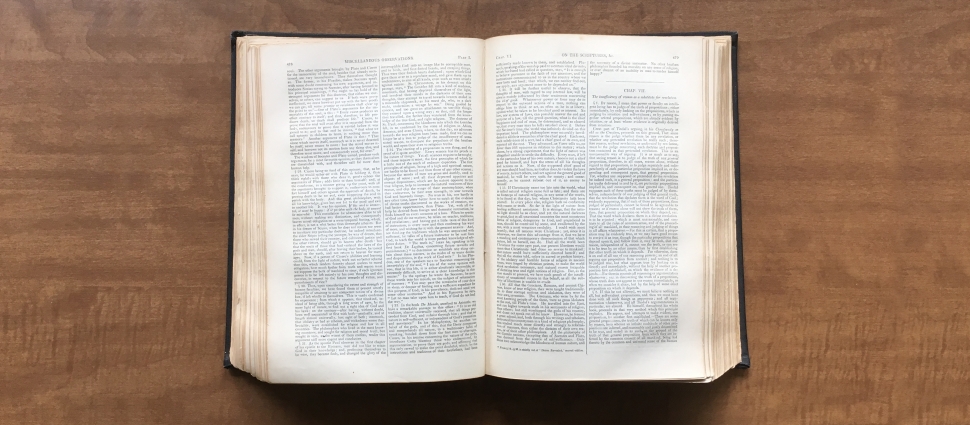Union with Christ

March 5, 2012
Robert Letham, Union with Christ: In Scripture, History, and Theology (P&R Publishing, 2011), xii + 164 pp.
In this volume Robert Letham takes up the grandest of all salvation truths, the Christian's union with Christ. After a short introduction, the book proceeds through six chapters in which Letham first sets forth the background and foundation of union with Christ (chs. 1-3), and then opens up the actual content of this union (chs. 4-6). I shall simply consider each chapter in turn and offer a few remarks on some strengths and weaknesses.
Chapter 1 examines the basis for our union with Christ as set down in creation. Since man is created in God's image, there is a fundamental compatibility between humans and God. Moreover, because Jesus is the express image of God's being, Letham concludes that it was most specifically in the Son's image that Adam was created. It is from that image that Adam fell and to that image that we are being renewed in Christ (14). Letham identifies man's original goal as bringing the cosmos into godly subjection. Now that everything has been put under the feet of Christ, we are able to achieve our creation aspiration in union with him (17).
Stimulating as this insight is, it is peculiar that there is no discussion of the higher goal of Adam's obedience, which was the fruition and enjoyment of God in glory in a confirmed and irrevocable sonship. Surely, such a discussion of this original ambition would have fit quite nicely with a consideration of Christ's own ambition as the second and last Adam.
Chapter 2 endeavors to show that the life we receive in union with Christ is nothing other that the divine life that Jesus received in his flesh via the hypostatic union. This becomes the book's most recurring theme, though it is not unproblematic (see below). Following Leonitus of Jerusalem, Letham writes, "The assumed humanity, deified in and by the Word, becomes the source of divine life since it is the Word's own flesh. Because Christ's humanity has divine life hypostatically, we can--in union with Christ--receive divine life by grace and participation" (33-34). The Son's assumption of humanity itself does not unite us to him or accomplish our salvation. Rather, as Letham correctly observes, "Christ's becoming man was to the end that he make complete and effective atonement for our sins on the cross, defeat death by his resurrection, and ascend in our nature to the right hand of God. There is no incarnation without atonement" (40-41). Still, it does seem that Letham regards the incarnation itself as at least partly constitutive of the redemption and new life that we receive in Christ. He states, "[T]he incarnation should not be seen as merely a means to salvation. Rather, salvation finds its ultimate fulfillment in the union of humanity with God seen in the incarnate Christ" (41).
Chapter 3 explains how it is that the incarnate Christ actually becomes beneficial to the believer through the agency of the Holy Spirit. First, Letham discusses the Spirit's activity in and with Christ throughout his earthly ministry and then his coming at Pentecost to indwell believers and unite them to Christ. Two aspects of the Spirit's work are emphasized: his production in us of the faith by which we apprehend Christ, and his role as witness to the sonship that we enjoy in our union with Christ. Overall, this treatment is a bit too hurried to be deeply instructive.
Chapter 4 shifts our focus onto Christ as our representative head. "Salvation in Christ," Letham observes, "is founded on a legal, forensic base" (57). We are in Jesus forensically inasmuch as he is our legal substitute. This chapter provides a fine primer on the classical Reformed doctrine of federal headship. As for our justification, Letham rightly links it to our union with Christ in his resurrection: "As Christ on the cross died to sin (Rom. 6:1f.)--in our place, on our behalf, and as one with us--so his resurrection, his public vindication by the Father, was in our place, on our behalf, and as one with us. Consequently, we died to sin in the death of Christ and rose to newness of life in his resurrection." Unfortunately, the author frequently leaves his scriptural references underdeveloped. His use of Romans 6, for instance, would have been much more instructive if he had included an explanation of the coordination between life and righteousness in Paul's theology. In what sense is resurrection in newness of life constitutive of Christ's justification and ours in him? How does this relate to the corresponding couplet in Paul's thought of death and condemnation in Adam? Anyhow, more patient exposition of biblical texts would have greatly enhanced the value of this book.
Chapter 5 constitutes a lengthy treatment of union with Christ and transformation. To begin, Letham offers a superb summary statement:
When Christ died and rose from the dead we died and rose with him, and so our status and existence was dramatically changed. Since . . . the Holy Spirit was sent to bring us to spiritual life and indwell and renew us, our participation in Christ's death and resurrection is vitally dynamic and transformative. These two elements are inseparable. This follows from who Christ is and what he has done. He, the Son of God incarnate, alive from the dead as our Mediator and Savior, was publically vindicated by the Father in his resurrection. We share, by grace, his status as the Son who achieved our salvation. With that status comes his risen and indestructible life, which is made ours by the Holy Spirit (85).
With such an auspicious start, one might have hoped for a thoroughgoing treatment of the meaning of Christ's death and resurrection and the implications of our participation in these realities. Instead, we are treated to an assortment of excurses on various salvation themes and historical figures. Some of these are useful in their own right, such as Letham's discussion of union with Christ in relation to the ordo salutis (88-90) and to the sacraments (120-22), and on union in John Calvin's thought (103-15). Also, his ten theses on union with Christ and transformation (123-28) provide a number of concise and cautionary insights on what the doctrine does and doesn't mean. Still, it is hard to discern the controlling logic of the chapter. Possibly the most awkwardly situated section is Letham's extended apologetic for theosis as the basis for the life we receive in Christ (91-102). One wonders how this doctrine is to be related to the chapter's opening emphasis upon Jesus' death and resurrection as the dynamic source of our spiritual transformation.
Chapter 6 focuses our attention on union with Christ in his death and resurrection. This chapter is somewhat enigmatic. Though Letham makes a number of references to Christ's death and resurrection throughout the volume, he rarely develops these doctrines in any detail. The lion's share of his argument is devoted to the thesis that Jesus' humanity as deified through the hypostatic union is the source of the new life we enjoy union with him. Now, the theosis doctrine virtually disappears from the argument and we are told, in words cited from Lane Tipton, that "there is no notion of redemptive life apart from the category of resurrection life, and this resurrection life is given in terms of union with Christ" (134). What are we to make of this after having been repeatedly told throughout the book that the life we receive from Jesus is that divine life he received in his flesh via the hypostatic union?
Inasmuch as that life was most certainly not resurrection life, how can Letham now say he agrees with Tipton that that only resurrection life constitutes redemptive life? When Letham writes that "it is union with [Christ] in his death and resurrection that all the blessing of salvation are given to us" (134-35), he makes a sound point. But what about the blessing of theosis? Wasn't that established for us prior to Christ's death and resurrection? In short, Letham seems to equivocate on the exact character of the life that Jesus conveys to us in union. Is it the life of Jesus deified (theosis) via personal union with his divine nature or the new life that Jesus receives in the resurrection? Or is it a combination of the two, and if so, how might we articulate this relationship? Though I think Letham makes a turn for the better with his concluding emphasis upon Jesus' resurrection life as the life we receive in union with him, such a turn seems to present insuperable challenges for his teaching that the life that saves us is the life Jesus received in his body from his divine nature at the point of the incarnation.
All in all, Union with Christ presents many glorious and precious truths, even if these are at times clouded by underdeveloped exegesis and a dubiously constructed doctrine of theosis.
James E. Dolezal (PhD, Westminster Theological Seminary) is Research Fellow at Craig Center for the Study of the Westminster Standards at Westminster Theological Seminary. He is the author of God Without Parts:Divine Simplicity and the Metaphysics of God's Absoluteness.




